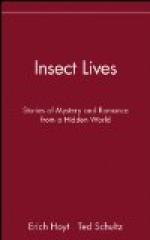in bridging, in thought, the gap between these two
methods of wing-growth, and has put forward an ingenious
suggestion to meet it (1902). Reference has already
been made to insects of various orders in which one
sex is wingless, the Vapourer Moth (p. 96) for example,
or all the individuals of both sexes are wingless,
as the aberrant cockroaches mentioned in Chapter II
(p. 15), or certain generations of virgin females are
wingless, for example aphids (pp. 18-19) and gall-flies
(pp. 94-5). Insects may thus become secondarily
wingless, that is to say be manifestly the offspring
of winged parents, and such wingless forms may on
the other hand give rise to offspring or descendants
with well-developed wings. Frequently, as in
the case of the aphids, many wingless generations
intervene between two winged generations. A striking
illustration of this fact is afforded by an aquatic
bug,
Velia currens, commonly to be seen skating
over the surface of running water. The adults
of Velia are nearly always wingless, but now and then
the naturalist meets with a specimen provided with
functional wings, the possession of which enables
the insect to make its way to a fresh stream.
Moreover there are whole orders of parasitic insects,
such as the lice and fleas, which, showing clear affinity
to orders of winged insects, are believed to be secondarily
wingless. These orders are designated by Sharp
‘Anapterygota.’ And from the analogy
of the periodic loss and recovery of wings in various
generations of the same species, he has concluded
that the gap between the exopterygote and the endopterygote
method of development may have been bridged by an
anapterygote condition; that the ancestors of those
insects with complete transformations were the wingless
descendants of primitive insects which grew their
wings from visible external rudiments, and that in
later times re-acquiring wings, they developed these
organs in a new way, from inwardly directed rudiments
or imaginal buds.
This theory of Sharp’s is original, daring,
and ingenious, but the loss and re-acquisition of
wings which it presupposes is difficult to imagine
in large groups during a prolonged evolutionary history,
while the sudden appearance of a totally new mode
of wing-growth in the offspring of wingless insects
would be an extreme example of discontinuity in development.
On the whole the most probable suggestion which can
be made as to the origin of ‘complete’
transformation in insects is that the instar in which
wings were first visible externally became later and
later in the course of the evolution of the more highly
organised groups. In this way a gradual transition
from the exopterygote to the endopterygote type of
life-story is at least conceivable. It will be
remembered that a may-fly (p. 33) undergoes a moult
after acquiring functional wings, emerging into the
air as a ‘sub-imago.’ In not a few
endopterygote insects, the pupa shows more or less
activity, swimming through water intermittently (gnats)




